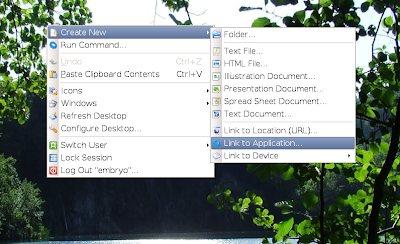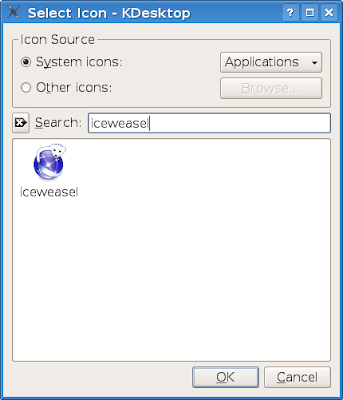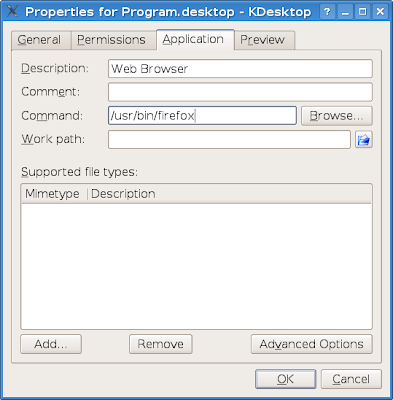In this tutorial I will show you two ways of creating launchers in KDE3, which comes with default in Debian Lenny and Kubuntu 8.04 LTS.
Method 1
To create a launcher, say on the desktop, just follow the next steps, also illustrated in the screenshots below:
Right click on any area on the desktop and go to Create New -> Link to Application....

Enter the name of your launcher, that is the name which will appear on the desktop, under the application's icon.

Select an icon for your launcher by clicking on the small blue wheel on the left side of the name.
Search for your icon and select it.

Next, go to the Application tab and enter a Description and the command you want executed when the launcher is clicked (usually these commands will be applications like Firefox or Amarok, which reside in /usr/bin/ or /usr/local/bin/.

I used /usr/bin/firefox in this example, although this is just a symbolic link to /usr/lib/iceweasel/iceweasel on Debian Lenny (which is Debian's version of Firefox).
Note that you may want to create a launcher to an application which has its binary elsewhere, so you will have to enter the full path to it. For example, if you have the Songbird directory saved under /home/your_username/Songbird/, you will enter /home/your_username/Songbird/songbird, and replace your_username.
Hit OK and that's it, your launcher should be now created.
Method 2
The second way to do this is by creating a text file with the extension .desktop. For example, to create a launcher to Firefox you would create the file firefox.desktop with Kate or another text editor (or any other name i.e. iceweasel.desktop), and add the following contents to it:
 Source URL: https://ashesgarrett.blogspot.com/2008/10/tip-of-day-create-launcher-in-kde3.html
Source URL: https://ashesgarrett.blogspot.com/2008/10/tip-of-day-create-launcher-in-kde3.html
Visit ashes garrett for Daily Updated Hairstyles Collection
Method 1
To create a launcher, say on the desktop, just follow the next steps, also illustrated in the screenshots below:
Right click on any area on the desktop and go to Create New -> Link to Application....

Enter the name of your launcher, that is the name which will appear on the desktop, under the application's icon.

Select an icon for your launcher by clicking on the small blue wheel on the left side of the name.
Search for your icon and select it.

Next, go to the Application tab and enter a Description and the command you want executed when the launcher is clicked (usually these commands will be applications like Firefox or Amarok, which reside in /usr/bin/ or /usr/local/bin/.

I used /usr/bin/firefox in this example, although this is just a symbolic link to /usr/lib/iceweasel/iceweasel on Debian Lenny (which is Debian's version of Firefox).
Note that you may want to create a launcher to an application which has its binary elsewhere, so you will have to enter the full path to it. For example, if you have the Songbird directory saved under /home/your_username/Songbird/, you will enter /home/your_username/Songbird/songbird, and replace your_username.
Hit OK and that's it, your launcher should be now created.
Method 2
The second way to do this is by creating a text file with the extension .desktop. For example, to create a launcher to Firefox you would create the file firefox.desktop with Kate or another text editor (or any other name i.e. iceweasel.desktop), and add the following contents to it:
[Desktop Entry]This will create a launcher just like the one we made at the first method.
Exec=/usr/bin/firefox
GenericName=Web Browser
Icon=iceweasel
Name=Firefox
Type=Application
 Source URL: https://ashesgarrett.blogspot.com/2008/10/tip-of-day-create-launcher-in-kde3.html
Source URL: https://ashesgarrett.blogspot.com/2008/10/tip-of-day-create-launcher-in-kde3.htmlVisit ashes garrett for Daily Updated Hairstyles Collection





